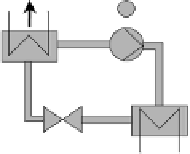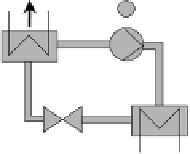Environmental Engineering Reference
In-Depth Information
heat. Recently there have been attempts to supply this heat - at least partially - by
thermal solar collectors.
A two-component mix (so-called working pairs) circulates within the solvent
circuit of the absorption heat pump. One of the components (working medium) is
highly soluble in the second component (solvent). Classic combinations of work-
ing pairs are water/lithiumbromide and ammonia/water. The first substance is al-
ways the working medium and the second the solvent.
The process within the condenser, expansion valve and the evaporator of the
absorption heat pump is identical with the compression heat pump. In contrast, the
compression process originates from two overlapping circuits with a different
level of pressure (Fig. 9.4).
The solvent pump enables the connection between the two pressure levels. It
needs considerably less drive energy than a compression heat pump, as a liquid
medium can be pushed to a high pressure level requiring less energy than a gase-
ous medium.
Useful
heat
Thermal
M
M
Solution
pump
compressor
Absorber
Absorber
Desorber
Expansion valve
(poor solution)
Supplied
heat
Dampf
Dampf
Vapour
Vapour
To h e a t s i n k
From heat source
Heat
(low
temperature)
Heat
(high
temperature)
From heat sink
To heat source
flüssig
Liquid
2-phase
Evaporator
Conde
n
ser
Expansion valve (refrigerant)
Fig. 9.4
Basic flow scheme of an absorption heat pump (see /9-1/)
In the absorber, the gaseous working medium from the evaporator (wa-
ter(water(H
2
O)/lithiumbromide(LiBr)) and ammonia (ammonia(NH
3
)/water
(H
2
O))) is absorbed by the concentrated solvent. Heat is released in the process.
The diluted solution is then pumped by increasing the pressure through the sol-
vent pump into the desorber, where the working medium is driven out of the sol-
vent again by adding heat (drive energy) and then reaches the condenser (lique-
fier). In a condensation process, it releases heat there. The working medium now
undergoes the same steps with the expansion valve and the evaporator as in com-
pression heat pumps. It again reaches the absorber in its gaseous form, while the
reduced solvent is transported directly from the desorber to the absorber again by







































Search WWH ::

Custom Search